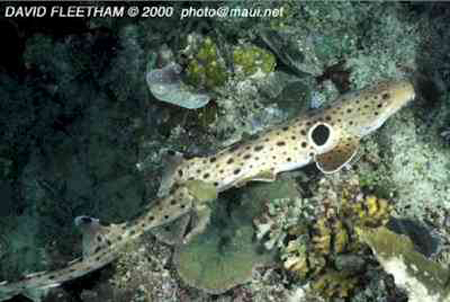|
|

|

Scientific Name:
Hemiscyllium ocellatus.
What To Look For:
A small slender cylindrical shark, mouth well ahead of eyes,
dorsal fins about the same size and a white-ringed black oval
spot on flank above the pectoral fin.
Color:
Tan with scattered black spots, and a very large white-ringed
black oval spot on its flank.
Size:
Maximum total length about 3.5 ft (1.07 mtrs).
Teeth:
Small and pointed with medial cusp.
Habitat:
Inshore bottom sharks, commonly in the intertidal, in tidepools
or coral reefs close inshore. They are abundant on reef flats of
islets in the Great Barrier Reef.
Distribution:
Western South Pacific: Australia (Northern Territory, Western
Australia, Queensland and New South Wales), New Guinea, and
possibly Malaysia and Sumatra.
Biology:
• Prey:
Invertebrates: worms, crabs, shrimp, small shellfish, and
probably small bottom fishes.
• Reproduction:
Oviparous.
Behaviour:
• General:
By day this small shark usually remains concealed beneath clumps
of coral. At night it roams the reef flats using its muscular
leg-like paired fins to clamber on the reef and into
crevices.
Disposition:
Usually placid. When grabbed by a diver the shark violently
contorts its body in an attempt to free itself.
• Danger To Humans:
None.
Note:
The speckled carpetshark, Hemiscyllium tn'speculare, is a similar
species with a similar range (Australian waters, and possibly
Indonesia) that grows to a length of 2 ft (60 cm). It also has a
large black circular spot above each pectoral fin The black spot
lacks a white ring, but it is partly edged with a few large dark
spots, and large and small dark spots on the shark's back form a
reticular pattern.
|

Back To Top
|
|